Afghanistan
Coordinates: 33°N 65°E / 33°N 65°E
| Islamic Republic of Afghanistan
|
||||||
|---|---|---|---|---|---|---|
|
||||||
| Motto: لا إله إلا الله، محمد رسول الله "Lā ʾilāha ʾillāl–lāh, Muhammadun rasūl Allāh" "There is no god but God; Muhammad is the messenger of God. (Shahada) |
||||||
| Anthem: Millī Surūd ملي سرود |
||||||
.svg.png) |
||||||
_-_AFG_-_UNOCHA.svg.png) |
||||||
| Capital and largest city | Kabul 34°32′N 69°08′E / 34.533°N 69.133°E | |||||
| Official languages | [1] | |||||
| Religion | Islam | |||||
| Demonym | Afghan[Note 1] | |||||
| Government | Unitary presidential Islamic republic | |||||
| • | President | Ashraf Ghani | ||||
| • | Chief Executive Officer | Abdullah Abdullah | ||||
| Legislature | National Assembly | |||||
| • | Upper house | House of Elders | ||||
| • | Lower house | House of the People | ||||
| Establishment | ||||||
| • | First Afghan state | April 1709 | ||||
| • | Recognized | 19 August 1919 | ||||
| Area | ||||||
| • | Total | 652,864[4] km2 (41st) 251,827 sq mi |
||||
| • | Water (%) | negligible | ||||
| Population | ||||||
| • | 2015 estimate | 32,564,342[5] (40th) | ||||
| • | Density | 49.88/km2 (150th) 111.8/sq mi |
||||
| GDP (PPP) | 2016 estimate | |||||
| • | Total | $65.295 billion[6] | ||||
| • | Per capita | $1,994[6] | ||||
| GDP (nominal) | 2016 estimate | |||||
| • | Total | $19.654 billion[6] | ||||
| • | Per capita | $600[6] | ||||
| Gini (2008) | 29[7] low |
|||||
| HDI (2014) | low · 171st |
|||||
| Currency | Afghani (AFN) | |||||
| Time zone | D† (UTC+4:30 Solar Calendar) | |||||
| Drives on the | right | |||||
| Calling code | +93 | |||||
| ISO 3166 code | AF | |||||
| Internet TLD | .af افغانستان. | |||||
Afghanistan ![]() i/æfˈɡænᵻstæn/ (Pashto/Dari: افغانستان, Afġānistān), officially the Islamic Republic of Afghanistan, is a landlocked country located within South Asia and Central Asia.[5][9] It has a population of approximately 32 million, making it the 42nd most populous country in the world. It is bordered by Pakistan in the south and east; Iran in the west; Turkmenistan, Uzbekistan, and Tajikistan in the north; and China in the far northeast. Its territory covers 652,000 km2 (252,000 sq mi), making it the 41st largest country in the world.
i/æfˈɡænᵻstæn/ (Pashto/Dari: افغانستان, Afġānistān), officially the Islamic Republic of Afghanistan, is a landlocked country located within South Asia and Central Asia.[5][9] It has a population of approximately 32 million, making it the 42nd most populous country in the world. It is bordered by Pakistan in the south and east; Iran in the west; Turkmenistan, Uzbekistan, and Tajikistan in the north; and China in the far northeast. Its territory covers 652,000 km2 (252,000 sq mi), making it the 41st largest country in the world.
Human habitation in Afghanistan dates back to the Middle Paleolithic Era, and the country's strategic location along the Silk Road connected it to the cultures of the Middle East and other parts of Asia. Through the ages the land has been home to various peoples and witnessed numerous military campaigns; notably by Alexander the Great, Mauryas, Muslim Arabs, Mongols, British, Soviet, and in the modern-era by Western powers. The land also served as the source from which the Kushans, Hephthalites, Samanids, Saffarids, Ghaznavids, Ghorids, Khiljis, Mughals, Hotaks, Durranis, and others have risen to form major empires.[10]
The political history of the modern state of Afghanistan began with the Hotak and Durrani dynasties in the 18th century. In the late 19th century, Afghanistan became a buffer state in the "Great Game" between British India and the Russian Empire. Following the Third Anglo-Afghan War in 1919, King Amanullah unsuccessfully attempted to modernize the country. It remained peaceful during Zahir Shah's forty years of monarchy. A series of coups in the 1970s was followed by a series of civil wars that devastated much of Afghanistan and continues to this day.
Etymology
The name Afghānistān (Pashto |افغانستان) is believed to be as old as the ethnonym Afghan, which is documented in the 10th-century geography book Hudud ul-'alam. The root name "Afghan" was used historically in reference to a member of the ethnic Pashtuns, and the suffix "-stan" means "place of" in Persian. Therefore, Afghanistan translates to land of the Afghans or, more specifically in a historical sense, to land of the Pashtuns. However, the modern Constitution of Afghanistan states that "[t]he word Afghan shall apply to every citizen of Afghanistan."[11]
History
Excavations of prehistoric sites by Louis Dupree and others suggest that humans were living in what is now Afghanistan at least 50,000 years ago, and that farming communities in the area were among the earliest in the world. An important site of early historical activities, many believe that Afghanistan compares to Egypt in terms of the historical value of its archaeological sites.[12][13]
The country sits at a unique nexus point where numerous civilizations have interacted and often fought. It has been home to various peoples through the ages, among them the ancient Iranian peoples who established the dominant role of Indo-Iranian languages in the region. At multiple points, the land has been incorporated within large regional empires, among them the Achaemenid Empire, the Macedonian Empire, the Indian Maurya Empire, and the Islamic Empire.[14]
Many empires and kingdoms have also risen to power in Afghanistan, such as the Greco-Bactrians, Kushans, Hephthalites, Kabul Shahis, Saffarids, Samanids, Ghaznavids, Ghurids, Khiljis, Kartids, Timurids, Mughals, and finally the Hotak and Durrani dynasties that marked the political origins of the modern state.[15]
Pre-Islamic period
Archaeological exploration done in the 20th century suggests that the geographical area of Afghanistan has been closely connected by culture and trade with its neighbors to the east, west, and north. Artifacts typical of the Paleolithic, Mesolithic, Neolithic, Bronze, and Iron ages have been found in Afghanistan. Urban civilization is believed to have begun as early as 3000 BCE, and the early city of Mundigak (near Kandahar in the south of the country) may have been a colony of the nearby Indus Valley Civilization. More recent findings established that the Indus Valley Civilisation stretched up towards modern-day Afghanistan, making the ancient civilisation today part of Pakistan, Afghanistan and India. In more detail, it extended from what today is northwest Pakistan to northwest India and northeast Afghanistan. An Indus Valley site has been found on the Oxus River at Shortugai in northern Afghanistan.[16][17] There are several smaller IVC colonies to be found in Afghanistan as well.

After 2000 BCE, successive waves of semi-nomadic people from Central Asia began moving south into Afghanistan; among them were many Indo-European-speaking Indo-Iranians. These tribes later migrated further into South Asia, Western Asia, and toward Europe via the area north of the Caspian Sea. The region at the time was referred to as Ariana.[12][18][19]
The religion Zoroastrianism is believed by some to have originated in what is now Afghanistan between 1800 and 800 BCE, as its founder Zoroaster is thought to have lived and died in Balkh. Ancient Eastern Iranian languages may have been spoken in the region around the time of the rise of Zoroastrianism. By the middle of the 6th century BCE, the Achaemenids overthrew the Medes and incorporated Arachosia, Aria, and Bactria within its eastern boundaries. An inscription on the tombstone of Darius I of Persia mentions the Kabul Valley in a list of the 29 countries that he had conquered.[20]
Alexander the Great and his Macedonian forces arrived to Afghanistan in 330 BCE after defeating Darius III of Persia a year earlier in the Battle of Gaugamela. Following Alexander's brief occupation, the successor state of the Seleucid Empire controlled the region until 305 BCE, when they gave much of it to the Maurya Empire as part of an alliance treaty. The Mauryans controlled the area south of the Hindu Kush until they were overthrown in about 185 BCE. Their decline began 60 years after Ashoka's rule ended, leading to the Hellenistic reconquest by the Greco-Bactrians. Much of it soon broke away from them and became part of the Indo-Greek Kingdom. They were defeated and expelled by the Indo-Scythians in the late 2nd century BCE.[21][22]
During the first century BCE, the Parthian Empire subjugated the region, but lost it to their Indo-Parthian vassals. In the mid-to-late first century CE the vast Kushan Empire, centered in Afghanistan, became great patrons of Buddhist culture, making Buddhism flourish throughout the region. The Kushans were overthrown by the Sassanids in the 3rd century CE, though the Indo-Sassanids continued to rule at least parts of the region. They were followed by the Kidarite who, in turn, were replaced by the Hephthalites. By the 6th century CE, the successors to the Kushans and Hepthalites established a small dynasty called Kabul Shahi. Much of the northeastern and southern areas of the country remained dominated by Buddhist culture.[23]
Islamization and Mongol invasion
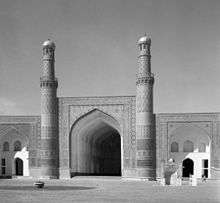
Arab Muslims brought Islam to Herat and Zaranj in 642 CE and began spreading eastward; some of the native inhabitants they encountered accepted it while others revolted. The land was collectively recognized by the Arabs as al-Hind due to its cultural connection with Greater India. Before Islam was introduced, people of the region were mostly Buddhists and Zoroastrians, but there were also Surya and Nana worshipers, Jews, and others. The Zunbils and Kabul Shahi were first conquered in 870 CE by the Saffarid Muslims of Zaranj. Later, the Samanids extended their Islamic influence south of the Hindu Kush. It is reported that Muslims and non-Muslims still lived side by side in Kabul before the Ghaznavids rose to power in the 10th century.[24][25][26]
By the 11th century, Mahmud of Ghazni defeated the remaining Hindu rulers and effectively Islamized the wider region, with the exception of Kafiristan. Afghanistan became one of the main centers in the Muslim world during this Islamic Golden Age. The Ghaznavid dynasty was overthrown by the Ghurids, who expanded and advanced the already powerful Islamic empire.
In 1219 AD, Genghis Khan and his Mongol army overran the region. His troops are said to have annihilated the Khorasanian cities of Herat and Balkh as well as Bamyan.[27] The destruction caused by the Mongols forced many locals to return to an agrarian rural society.[28] Mongol rule continued with the Ilkhanate in the northwest while the Khilji dynasty administered the Afghan tribal areas south of the Hindu Kush until the invasion of Timur, who established the Timurid Empire in 1370.
In the early 16th century, Babur arrived from Fergana and captured Kabul from the Arghun dynasty. In 1526, he invaded Delhi in India to replace the Lodi dynasty with the Mughal Empire. Between the 16th and 18th century, the Khanate of Bukhara, Safavids, and Mughals ruled parts of the territory. Before the 19th century, the northwestern area of Afghanistan was referred to by the regional name Khorasan. Two of the four capitals of Khorasan (Herat and Balkh) are now located in Afghanistan, while the regions of Kandahar, Zabulistan, Ghazni, Kabulistan, and Afghanistan formed the frontier between Khorasan and Hindustan.[29][30][31]
Hotak dynasty and Durrani Empire
In 1709, Mirwais Hotak, a local Ghilzai tribal leader, successfully rebelled against the Safavids. He defeated Gurgin Khan and made Afghanistan independent.[32] Mirwais died of a natural cause in 1715 and was succeeded by his brother Abdul Aziz, who was soon killed by Mirwais' son Mahmud for treason. Mahmud led the Afghan army in 1722 to the Persian capital of Isfahan, captured the city after the Battle of Gulnabad and proclaimed himself King of Persia.[32] The Afghan dynasty was ousted from Persia by Nader Shah after the 1729 Battle of Damghan.
In 1738, Nader Shah and his forces captured Kandahar, the last Hotak stronghold, from Shah Hussain Hotak, at which point the incarcerated 16-year-old Ahmad Shah Durrani was freed and made the commander of an Afghan regiment. Soon after the Persian and Afghan forces invaded India. By 1747, the Afghans chose Durrani as their head of state.[33] Durrani and his Afghan army conquered much of present-day Afghanistan, Pakistan, the Khorasan and Kohistan provinces of Iran, and Delhi in India.[34] He defeated the Indian Maratha Empire, and one of his biggest victories was the 1761 Battle of Panipat.
In October 1772, Durrani died of a natural cause and was buried at a site now adjacent to the Shrine of the Cloak in Kandahar. He was succeeded by his son, Timur Shah, who transferred the capital of Afghanistan from Kandahar to Kabul in 1776. After Timur's death in 1793, the Durrani throne passed down to his son Zaman Shah, followed by Mahmud Shah, Shuja Shah and others.[35]
The Afghan Empire was under threat in the early 19th century by the Persians in the west and the Sikh Empire in the east. Fateh Khan, leader of the Barakzai tribe, had installed 21 of his brothers in positions of power throughout the empire. After his death, they rebelled and divided up the provinces of the empire between themselves. During this turbulent period, Afghanistan had many temporary rulers until Dost Mohammad Khan declared himself emir in 1826.[36] The Punjab region was lost to Ranjit Singh, who invaded Khyber Pakhtunkhwa and in 1834 captured the city of Peshawar.[37] In 1837, during the Battle of Jamrud near the Khyber Pass, Akbar Khan and the Afghan army failed to capture the Jamrud fort from the Sikh Khalsa Army, but killed Sikh Commander Hari Singh Nalwa, thus ending the Afghan-Sikh Wars. By this time the British were advancing from the east and the first major conflict during the "Great Game" was initiated.[38]
Western influence

In 1838, the British marched into Afghanistan and arrested Dost Mohammad, sent him into exile in India and replaced him with the previous ruler, Shah Shuja.[39][40] Following an uprising, the 1842 retreat from Kabul of British-Indian forces, and the Battle of Kabul that led to its recapture, the British placed Dost Mohammad Khan back into power and withdrew their military forces from Afghanistan. In 1878, the Second Anglo-Afghan War was fought over perceived Russian influence, Abdur Rahman Khan replaced Ayub Khan, and Britain gained controlled Afghanistan's foreign relations as part of the Treaty of Gandamak of 1879. In 1893, Mortimer Durand made Amir Abdur Rahman Khan sign a controversial agreement in which the ethnic Pashtun and Baloch territories were divided by the Durand Line. This was a standard divide and rule policy of the British and would lead to strained relations, especially with the later new state of Pakistan.
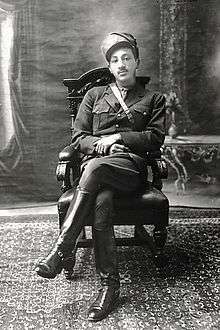
After the Third Anglo-Afghan War and the signing of the Treaty of Rawalpindi on 19 August 1919, King Amanullah Khan declared Afghanistan a sovereign and fully independent state. He moved to end his country's traditional isolation by establishing diplomatic relations with the international community and, following a 1927–28 tour of Europe and Turkey, introduced several reforms intended to modernize his nation. A key force behind these reforms was Mahmud Tarzi, an ardent supporter of the education of women. He fought for Article 68 of Afghanistan's 1923 constitution, which made elementary education compulsory. The institution of slavery was abolished in 1923.[41]
Some of the reforms that were actually put in place, such as the abolition of the traditional burqa for women and the opening of a number of co-educational schools, quickly alienated many tribal and religious leaders. Faced with overwhelming armed opposition, Amanullah Khan was forced to abdicate in January 1929 after Kabul fell to rebel forces led by Habibullah Kalakani. Prince Mohammed Nadir Shah, Amanullah's cousin, in turn defeated and killed Kalakani in November 1929, and was declared King Nadir Shah. He abandoned the reforms of Amanullah Khan in favor of a more gradual approach to modernisation but was assassinated in 1933 by Abdul Khaliq, a Hazara school student.
Mohammed Zahir Shah, Nadir Shah's 19-year-old son, succeeded to the throne and reigned from 1933 to 1973. Until 1946, Zahir Shah ruled with the assistance of his uncle, who held the post of Prime Minister and continued the policies of Nadir Shah. Another of Zahir Shah's uncles, Shah Mahmud Khan, became Prime Minister in 1946 and began an experiment allowing greater political freedom, but reversed the policy when it went further than he expected. He was replaced in 1953 by Mohammed Daoud Khan, the king's cousin and brother-in-law. Daoud Khan sought a closer relationship with the Soviet Union and a more distant one towards Pakistan. Afghanistan remained neutral and was neither a participant in World War II nor aligned with either power bloc in the Cold War. However, it was a beneficiary of the latter rivalry as both the Soviet Union and the United States vied for influence by building Afghanistan's main highways, airports, and other vital infrastructure. On per capita basis, Afghanistan received more Soviet development aid than any other country. In 1973, while King Zahir Shah was on an official overseas visit, Daoud Khan launched a bloodless coup and became the first President of Afghanistan. In the meantime, Zulfikar Ali Bhutto got neighboring Pakistan involved in Afghanistan. Some experts suggest that Bhutto paved the way for the April 1978 Saur Revolution.[42]
Marxist revolution and Soviet war
.jpg)
In April 1978, the communist People's Democratic Party of Afghanistan (PDPA) seized power in Afghanistan in the Saur Revolution. Within months, opponents of the communist government launched an uprising in eastern Afghanistan that quickly expanded into a civil war waged by guerrilla mujahideen against government forces countrywide. The Pakistani government provided these rebels with covert training centers, while the Soviet Union sent thousands of military advisers to support the PDPA government.[43] Meanwhile, increasing friction between the competing factions of the PDPA — the dominant Khalq and the more moderate Parcham — resulted in the dismissal of Parchami cabinet members and the arrest of Parchami military officers under the pretext of a Parchami coup.
In September 1979, Nur Muhammad Taraki was assassinated in a coup within the PDPA orchestrated by fellow Khalq member Hafizullah Amin, who assumed the presidency. Distrusted by the Soviets, Amin was assassinated by Soviet special forces in December 1979. A Soviet-organized government, led by Parcham's Babrak Karmal but inclusive of both factions, filled the vacuum. Soviet troops were deployed to stabilize Afghanistan under Karmal in more substantial numbers, although the Soviet government did not expect to do most of the fighting in Afghanistan. As a result, however, the Soviets were now directly involved in what had been a domestic war in Afghanistan.[44] The PDPA prohibited usury, declared equality of the sexes,[45] and introduced women to political life.[45]
The United States had been supporting anti-Soviet Afghan mujahideen and foreign "Afghan Arab" fighters through Pakistan's ISI as early as mid-1979 (see CIA activities in Afghanistan).[46] Billions in cash and weapons, which included over two thousand FIM-92 Stinger surface-to-air missiles, were provided by the United States and Saudi Arabia to Pakistan.[47][48]
The Soviet war in Afghanistan resulted in the deaths of over 1 million Afghans, mostly civilians,[49][50][51] and the creation of about 6 million refugees who fled Afghanistan, mainly to Pakistan and Iran.[52] Faced with mounting international pressure and numerous casualties, the Soviets withdrew in 1989 but continued to support Afghan President Mohammad Najibullah until 1992.[53]
Civil war
From 1989 until 1992, Najibullah's government tried to solve the ongoing civil war with economic and military aid, but without Soviet troops on the ground. Najibullah tried to build support for his government by portraying his government as Islamic, and in the 1990 constitution the country officially became an Islamic state and all references of communism were removed. Nevertheless, Najibullah did not win any significant support, and with the dissolution of the Soviet Union in December 1991, he was left without foreign aid. This, coupled with the internal collapse of his government, led to his ousting from power in April 1992. After the fall of Najibullah's government in 1992, the post-communist Islamic State of Afghanistan was established by the Peshawar Accord, a peace and power-sharing agreement under which all the Afghan parties were united in April 1992, except for the Pakistani supported Hezb-e Islami of Gulbuddin Hekmatyar. Hekmatyar started a bombardment campaign against the capital city Kabul, which marked the beginning of a new phase in the war.[54]
Saudi Arabia and Iran supported different Afghan militias[55][56][57] and instability quickly developed.[58] The conflict between the two militias soon escalated into a full-scale war.
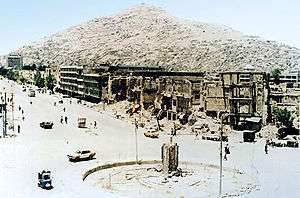
Due to the sudden initiation of the war, working government departments, police units, and a system of justice and accountability for the newly created Islamic State of Afghanistan did not have time to form. Atrocities were committed by individuals of the different armed factions while Kabul descended into lawlessness and chaos.[56][59] Because of the chaos, some leaders increasingly had only nominal control over their (sub-)commanders.[60] For civilians there was little security from murder, rape, and extortion.[60] An estimated 25,000 people died during the most intense period of bombardment by Hekmatyar's Hezb-i Islami and the Junbish-i Milli forces of Abdul Rashid Dostum, who had created an alliance with Hekmatyar in 1994.[59] Half a million people fled Afghanistan.[60]
Southern and eastern Afghanistan were under the control of local commanders such as Gul Agha Sherzai and others. In 1994, the Taliban (a movement originating from Jamiat Ulema-e-Islam-run religious schools for Afghan refugees in Pakistan) also developed in Afghanistan as a political-religious force.[61] The Taliban first took control of southern Afghanistan in 1994 and forced the surrender of dozens of local Pashtun leaders.[60]
In late 1994, forces of Ahmad Shah Massoud held on to Kabul.[62] Rabbani's government took steps to reopen courts, restore law and order, and initiate a nationwide political process with the goal of national consolidation and democratic elections. Massoud invited Taliban leaders to join the process but they refused.[63]
Taliban Emirate and Northern Alliance
The Taliban's early victories in late 1994 were followed by a series of defeats that resulted in heavy losses. The Taliban attempted to capture Kabul in early 1995 but were repelled by forces under Massoud. In September 1996, as the Taliban, with military support from Pakistan[64] and financial support from Saudi Arabia, prepared for another major offensive, Massoud ordered a full retreat from Kabul.[65] The Taliban seized Kabul in the same month and established the Islamic Emirate of Afghanistan. They imposed a strict form of Sharia, similar to that found in Saudi Arabia. According to Physicians for Human Rights (PHR), "no other regime in the world has methodically and violently forced half of its population into virtual house arrest, prohibiting them on pain of physical punishment from showing their faces, seeking medical care without a male escort, or attending school"[66] (this statement, though, was made in 1998, long before the advent of ISIS which has imposed even tougher and more violent sharia controls).
After the fall of Kabul to the Taliban, Massoud and Dostum formed the Northern Alliance. The Taliban defeated Dostum's forces during the Battles of Mazar-i-Sharif (1997–98). Pakistan's Chief of Army Staff, Pervez Musharraf, began sending thousands of Pakistanis to help the Taliban defeat the Northern Alliance.[63][64][67][68][69][70] From 1996 to 2001, the al-Qaeda network of Osama bin Laden and Ayman al-Zawahiri was also operating inside Afghanistan.[71] This and the fact that around one million Afghans were internally displaced made the United States worry.[67][72] From 1990 to September 2001, around 400,000 Afghans died in the internal mini-wars.[73]
On 9 September 2001, Massoud was assassinated by two Arab suicide attackers in Panjshir province of Afghanistan. Two days later, the September 11 attacks were carried out in the United States. The US government suspected Osama bin Laden as the perpetrator of the attacks, and demanded that the Taliban hand him over.[74] After refusing to comply, the October 2001 Operation Enduring Freedom was launched. During the initial invasion, US and UK forces bombed al-Qaeda training camps. The United States began working with the Northern Alliance to remove the Taliban from power.[75]
Recent history (2002–present)
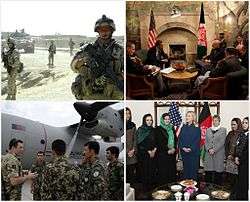
In December 2001, after the Taliban government was overthrown and the new Afghan government under President Hamid Karzai was formed, the International Security Assistance Force (ISAF) was established by the UN Security Council to help assist the Karzai administration and provide basic security.[76][77] Taliban forces also began regrouping inside Pakistan, while more coalition troops entered Afghanistan and began rebuilding the war-torn country.[78][79]
Shortly after their fall from power, the Taliban began an insurgency to regain control of Afghanistan. Over the next decade, ISAF and Afghan troops led many offensives against the Taliban but failed to fully defeat them. Afghanistan remains one of the poorest countries in the world due to a lack of foreign investment, government corruption, and the Taliban insurgency.[80][81]
Meanwhile, the Afghan government was able to build some democratic structures, and the country changed its name to the Islamic Republic of Afghanistan. Attempts were made, often with the support of foreign donor countries, to improve the country's economy, healthcare, education, transport, and agriculture. ISAF forces also began to train the Afghan National Security Forces. In the decade following 2002, over five million Afghans were repatriated, including some who were forcefully deported from Western countries.[82][83]
By 2009, a Taliban-led shadow government began to form in parts of the country.[84] In 2010, President Karzai attempted to hold peace negotiations with the Taliban leaders, but the rebel group refused to attend until mid-2015 when the Taliban supreme leader finally decided to back the peace talks.[85]
After the May 2011 death of Osama bin Laden in Pakistan, many prominent Afghan figures were assassinated.[86] Afghanistan–Pakistan border skirmishes intensified and many large scale attacks by the Pakistan-based Haqqani Network also took place across Afghanistan. The United States blamed rogue elements within the Pakistani government for the increased attacks.[87][88] The U.S. government spent tens of billions of dollars on development aid over 15 years and over a trillion dollars on military expenses during the same period. Corruption by Western defense and development contractors and associated Afghans reached unprecedented levels in a country where the national GDP was often only a small fraction of the U.S. government's annual budget for the conflict.[89]
Following the 2014 presidential election President Karzai left power and Ashraf Ghani became President in September 2014.[90] The US war in Afghanistan (America's longest war) officially ended on 28 December 2014. However, thousands of US-led NATO troops have remained in the country to train and advise Afghan government forces.[91] The 2001–present war has resulted in over 90,000 direct war-related deaths, which includes insurgents, Afghan civilians and government forces. Over 100,000 have been injured.[92]
Geography
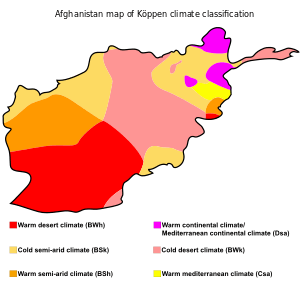
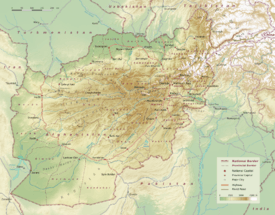
A landlocked mountainous country with plains in the north and southwest, Afghanistan is located within South Asia[9][93] and Central Asia.[94] It is part of the US-coined Greater Middle East Muslim world, which lies between latitudes 29° N and 39° N, and longitudes 60° E and 75° E. The country's highest point is Noshaq, at 7,492 m (24,580 ft) above sea level. It has a continental climate with harsh winters in the central highlands, the glaciated northeast (around Nuristan), and the Wakhan Corridor, where the average temperature in January is below −15 °C (5 °F), and hot summers in the low-lying areas of the Sistan Basin of the southwest, the Jalalabad basin in the east, and the Turkestan plains along the Amu River in the north, where temperatures average over 35 °C (95 °F) in July.
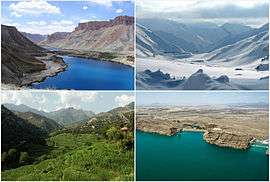
Despite having numerous rivers and reservoirs, large parts of the country are dry. The endorheic Sistan Basin is one of the driest regions in the world.[95] Aside from the usual rainfall, Afghanistan receives snow during the winter in the Hindu Kush and Pamir Mountains, and the melting snow in the spring season enters the rivers, lakes, and streams.[96][97] However, two-thirds of the country's water flows into the neighboring countries of Iran, Pakistan, and Turkmenistan. The state needs more than US$2 billion to rehabilitate its irrigation systems so that the water is properly managed.[98]
The northeastern Hindu Kush mountain range, in and around the Badakhshan Province of Afghanistan, is in a geologically active area where earthquakes may occur almost every year.[99] They can be deadly and destructive sometimes, causing landslides in some parts or avalanches during the winter.[100] The last strong earthquakes were in 1998, which killed about 6,000 people in Badakhshan near Tajikistan.[101] This was followed by the 2002 Hindu Kush earthquakes in which over 150 people were killed and over 1,000 injured. A 2010 earthquake left 11 Afghans dead, over 70 injured, and more than 2,000 houses destroyed.
The country's natural resources include: coal, copper, iron ore, lithium, uranium, rare earth elements, chromite, gold, zinc, talc, barites, sulfur, lead, marble, precious and semi-precious stones, natural gas, and petroleum, among other things.[102][103] In 2010, US and Afghan government officials estimated that untapped mineral deposits located in 2007 by the US Geological Survey are worth between $900 bn and $3 trillion.[104]
At 652,230 km2 (251,830 sq mi),[105] Afghanistan is the world's 41st largest country,[106] slightly bigger than France and smaller than Burma, about the size of Texas in the United States. It borders Pakistan in the south and east; Iran in the west; Turkmenistan, Uzbekistan, and Tajikistan in the north; and China in the far east.
Demographics
As of 2015, the population of Afghanistan is around 32,564,342,[5] which includes the roughly 2.7 million Afghan refugees still living in Pakistan and Iran. As of 2013 46% of Afghanistan's population are under 15 years of age and 74% of the population live in rural areas.[107] The average woman gave birth to five children during her life and 6.8% of all babies died in child-birth or infancy.[107] Life expectancy in 2013 was 60 years and only .1% of the population between ages 15 and 49 had HIV.[107]
Like many of its neighboring countries, Afghanistan has an ethnically, linguistically and religiously diverse population. According to cartographer Michael Izady there "is precious little correspondence between language and ethnic or group identity in Afghanistan. Connections such as tribe (e.g. Pashtuns, Aimaqs), religion (e.g. the Shia Hazaras, Sayyids, Kizilbash), group memory (e.g. Arabs and Monghols/Mongols) or life style (e.g. Parsiwans) are far more important markers of group identity than language has ever been. Only Turkmens (totally) and Uzbeks (mostly) are to be identified with languages that they speak. This has been so since the inception of the state in AD 1747."[108]
Afghanistan has experienced a gradual urbanization since the late 1990s but the country remains one of the world's least urban societies. In 1999 around 79% of the country's population lived in rural areas compared to around 74% in 2014.[107] The only city with over a million residents is its capital, Kabul. Other large cities in the country are, in order of population size, Kandahar, Herat, Mazar-i-Sharif, Jalalabad, Lashkar Gah, Taloqan, Khost, Sheberghan, and Ghazni. According to the Population Reference Bureau, the Afghan population is estimated to increase to 82 million by 2050.[109]
| | |||||||||
|---|---|---|---|---|---|---|---|---|---|
| Rank | Name | Province | Pop. | ||||||
 Kabul 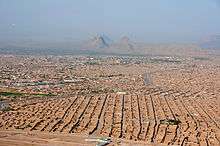 Kandahar |
1 | Kabul | Kabul Province | 3,289,000 | 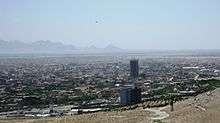 Herat 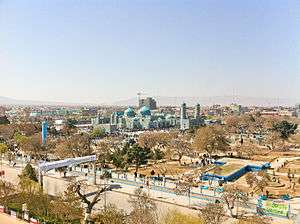 Mazar-i-Sharif | ||||
| 2 | Kandahar | Kandahar Province | 491,500 | ||||||
| 3 | Herat | Herat Province | 436,300 | ||||||
| 4 | Mazar-i-Sharif | Balkh Province | 368,100 | ||||||
| 5 | Kunduz | Kunduz Province | 304,600 | ||||||
| 6 | Taloqan | Takhar Province | 219,000 | ||||||
| 7 | Jalalabad | Nangarhar Province | 206,500 | ||||||
| 8 | Puli Khumri | Baghlan Province | 203,600 | ||||||
| 9 | Charikar | Parwan Province | 171,200 | ||||||
| 10 | Sheberghan | Jowzjan Province | 161,700 | ||||||
Ethnic groups

Afghanistan is a multiethnic society, and its historical status as a crossroads has contributed significantly to its diverse ethnic makeup. The population of the country is divided into a wide variety of ethnolinguistic groups. Because a systematic census has not been held in the nation in decades, exact figures about the size and composition of the various ethnic groups are unavailable. An approximate distribution of the ethnic groups is shown in the chart below:
| Ethnic group | 2004–2014 estimate[111] | Pre-2004 estimate[112][113][114][115] |
|---|---|---|
| Pashtun | 42% | 38–55% |
| Tajik | 27% | 26% (of this 1% are Qizilbash) |
| Hazara | 8% | 9–10% |
| Uzbek | 9% | 6–8% |
| Aimaq | 4% | 500,000 to 800,000 |
| Turkmen | 3% | 2.5% |
| Baloch | 2% | 100,000 |
| Others (Pashayi, Nuristani, Arab, Brahui, Pamiri, Gurjar, etc.) | 4% | 6.9% |
Languages
Pashto and Dari are the official languages of Afghanistan; bilingualism is very common.[1] Both are Indo-European languages from the Iranian languages sub-family. Dari (Afghan Persian) has long been the prestige language and a lingua franca for inter-ethnic communication. It is the native tongue of the Tajiks, Hazaras, Aimaks, and Kizilbash.[116] Pashto is the native tongue of the Pashtuns, although many Pashtuns often use Dari and some non-Pashtuns are fluent in Pashto.
Other languages, including Uzbek, Arabic, Turkmen, Balochi, Pashayi, and Nuristani languages (Ashkunu, Kamkata-viri, Vasi-vari, Tregami, and Kalasha-ala), are the native tongues of minority groups across the country and have official status in the regions where they are widely spoken. Minor languages also include Pamiri (Shughni, Munji, Ishkashimi, and Wakhi), Brahui, Hindko, and Kyrgyz. A small percentage of Afghans are also fluent in Urdu, English, and other languages.
Gender
Afghanistan was listed in 2002 as one of the most dangerous countries in the world to be born a woman according to a global survey due to amont the highest maternal mortality rates in the world, where half a million die annually in childbirth. The high rate is caused by the healthcare system having been destroyed by warfare and the Taliban.[117]
Religions
Over 99% of the Afghan population is Muslim; up to 90% are from the Sunni branch, 7–19% are Shia.[5][21][118]
Until the 1890s, the region around Nuristan was known as Kafiristan (land of the kafirs (unbelievers)) because of its non-Muslim inhabitants, the Nuristanis, an ethnically distinct people whose religious practices included animism, polytheism, and shamanism.[119] Thousands of Afghan Sikhs and Hindus are also found in the major cities.[120][121] There was a small Jewish community in Afghanistan who had emigrated to Israel and the United States by the end of the twentieth century; only one Jew, Zablon Simintov, remained by 2005.[122]
Governance

.svg.png)
Afghanistan is an Islamic republic consisting of three branches, the executive, legislative, and judicial. The nation is led by President Ashraf Ghani with Abdul Rashid Dostum and Sarwar Danish as vice presidents. Abdullah Abdullah serves as the chief executive officer (CEO). The National Assembly is the legislature, a bicameral body having two chambers, the House of the People and the House of Elders. The Supreme Court is led by Chief Justice Said Yusuf Halem, the former Deputy Minister of Justice for Legal Affairs.[123][124]
A January 2010 report published by the United Nations Office on Drugs and Crime revealed that bribery consumed an amount equal to 23% of the GDP of the nation.[125] A number of government ministries are believed to be rife with corruption, and while President Karzai vowed to tackle the problem in late 2009 by stating that "individuals who are involved in corruption will have no place in the government",[126] top government officials were stealing and misusing hundreds of millions of dollars through the Kabul Bank. According to Transparency International's 2014 corruption perceptions index results, Afghanistan was ranked as the fourth most corrupt country in the world.[127]
Elections and parties
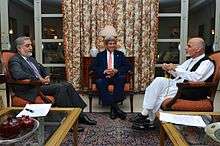
The 2004 Afghan presidential election was relatively peaceful, in which Hamid Karzai won in the first round with 55.4% of the votes. However, the 2009 presidential election was characterized by lack of security, low voter turnout, and widespread electoral fraud.[128] The vote, along with elections for 420 provincial council seats, took place in August 2009, but remained unresolved during a lengthy period of vote counting and fraud investigation.
Two months later, under international pressure, a second round run-off vote between Karzai and remaining challenger Abdullah was announced, but a few days later Abdullah announced that he would not participate in 7 November run-off because his demands for changes in the electoral commission had not been met. The next day, officials of the election commission cancelled the run-off and declared Hamid Karzai as President for another five-year term.[128]
In the 2005 parliamentary election, among the elected officials were former mujahideen, Islamic fundamentalists, warlords, communists, reformists, and several Taliban associates.[129] In the same period, Afghanistan reached to the 30th highest nation in terms of female representation in parliament.[130] The last parliamentary election was held in September 2010, but due to disputes and investigation of fraud, the swearing-in ceremony took place in late January 2011. The 2014 presidential election ended with Ashraf Ghani winning by 56.44% votes.
Administrative divisions
Afghanistan is administratively divided into 34 provinces (wilayats), with each province having its own capital and a provincial administration. The provinces are further divided into about 398 smaller provincial districts, each of which normally covers a city or a number of villages. Each district is represented by a district governor.
The provincial governors are appointed by the President of Afghanistan and the district governors are selected by the provincial governors. The provincial governors are representatives of the central government in Kabul and are responsible for all administrative and formal issues within their provinces. There are also provincial councils that are elected through direct and general elections for a period of four years.[131] The functions of provincial councils are to take part in provincial development planning and to participate in the monitoring and appraisal of other provincial governance institutions.
According to article 140 of the constitution and the presidential decree on electoral law, mayors of cities should be elected through free and direct elections for a four-year term. However, due to huge election costs, mayoral and municipal elections have never been held. Instead, mayors have been appointed by the government. In the capital city of Kabul, the mayor is appointed by the President of Afghanistan.
The following is a list of all the 34 provinces in alphabetical order:
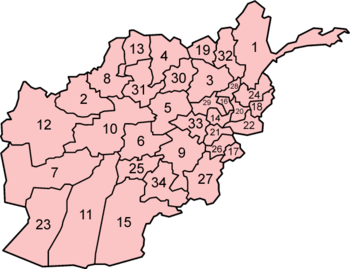
Foreign relations and military
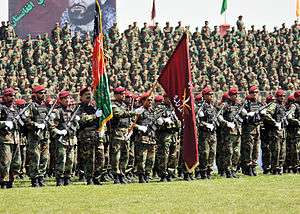
The Afghan Ministry of Foreign Affairs is in charge of maintaining the foreign relations of Afghanistan. The state has been a member of the United Nations since 1946. It enjoys strong economic relations with a number of NATO and allied states, particularly the United States, United Kingdom, Germany and Turkey. In 2012, the United States designated Afghanistan as a major non-NATO ally and created the U.S.–Afghanistan Strategic Partnership Agreement. Afghanistan also has friendly diplomatic relations with neighboring Pakistan, Iran, Turkmenistan, Uzbekistan, Tajikistan, and China, and with regional states such as India, Bangladesh, Nepal, Kazakhstan, Russia, the UAE, Saudi Arabia, Iraq, Egypt, Japan, and South Korea. It continues to develop diplomatic relations with other countries around the world.
United Nations Assistance Mission in Afghanistan (UNAMA) was established in 2002 under United Nations Security Council Resolution 1401 in order to help the country recover from decades of war. Today, a number of NATO member states deploy about 38,000 troops in Afghanistan as part of the International Security Assistance Force (ISAF).[132] Its main purpose is to train the Afghan National Security Forces (ANSF). The Afghan Armed Forces are under the Ministry of Defense, which includes the Afghan National Army (ANA) and the Afghan Air Force (AAF). The ANA is divided into 7 major Corps, with the 201st Selab ("Flood") in Kabul followed by the 203rd in Gardez, 205th Atul ("Hero") in Kandahar, 207th in Herat, 209th in Mazar-i-Sharif, and the 215th in Lashkar Gah. The ANA also has a commando brigade, which was established in 2007. The Afghan Defense University (ADU) houses various educational establishments for the Afghan Armed Forces, including the National Military Academy of Afghanistan.[133]
Law enforcement

The National Directorate of Security (NDS) is the nation's domestic intelligence agency, which operates similar to that of the United States Department of Homeland Security (DHS) and has between 15,000 and 30,000 employees. The nation also has about 126,000 national police officers, with plans to recruit more so that the total number can reach 160,000.[134] The Afghan National Police (ANP) is under the Ministry of the Interior and serves as a single law enforcement agency all across the country. The Afghan National Civil Order Police is the main branch of the ANP, which is divided into five Brigades, each commanded by a Brigadier General. These brigades are stationed in Kabul, Gardez, Kandahar, Herat, and Mazar-i-Sharif. Every province has an appointed provincial Chief of Police who is responsible for law enforcement throughout the province.
The police receive most of their training from Western forces under the NATO Training Mission-Afghanistan. According to a 2009 news report, a large proportion of police officers were illiterate and accused of demanding bribes.[135] Jack Kem, deputy to the commander of NATO Training Mission Afghanistan and Combined Security Transition Command Afghanistan, stated that the literacy rate in the ANP would rise to over 50% by January 2012. What began as a voluntary literacy program became mandatory for basic police training in early 2011.[134] Approximately 17% of them tested positive for illegal drug use. In 2009, President Karzai created two anti-corruption units within the Interior Ministry.[136] Former Interior Minister Hanif Atmar said that security officials from the US (FBI), Britain (Scotland Yard), and the European Union will train prosecutors in the unit.
All parts of Afghanistan are considered dangerous due to militant activities. Hundreds of Afghan police are killed in the line of duty each year. Kidnapping and robberies are also reported. The Afghan Border Police (ABP) are responsible for protecting the nation's airports and borders, especially the disputed Durand Line border, which is often used by members of criminal organizations and terrorists for their illegal activities. A report in 2011 suggested that up to 3 million people were involved in the illegal drug business in Afghanistan. Attacks on government employees may be ordered by powerful mafia groups who reside inside and outside the country. Drugs from Afghanistan are exported to neighboring countries and then to other countries. The Afghan Ministry of Counter Narcotics is tasked to deal with these issues by bringing to justice major drug traffickers.[137]
Women may be tried and convicted for breaking social norms, such as running away from a forced marriage or abusive husband. Victims of rape may be jailed for having had sex outside of marriage.[138]
Economy
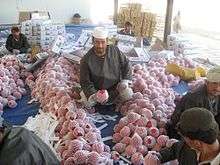
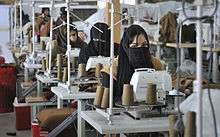
Afghanistan is an impoverished least developed country, one of the world's poorest because of decades of war and lack of foreign investment. As of 2014, the nation's GDP stands at about $60.58 billion with an exchange rate of $20.31 billion, and the GDP per capita is $1,900. The country's exports totaled $2.7 billion in 2012. Its unemployment rate was reported in 2008 at about 35%.[5] According to a 2009 report, about 42% of the population lives on less than $1 a day.[139] The nation has less than $1.5 billion in external debt.[5]
The Afghan economy has been growing at about 10% per year in the last decade, which is due to the infusion of over $50 billion in international aid and remittances from Afghan expats.[5] It is also due to improvements made to the transportation system and agricultural production, which is the backbone of the nation's economy.[140] The country is known for producing some of the finest pomegranates, grapes, apricots, melons, and several other fresh and dry fruits, including nuts.[141] Many sources indicate that as much as 11% or more of Afghanistan's economy is derived from the cultivation and sale of opium, and Afghanistan is widely considered the world's largest producer of opium despite Afghan government and international efforts to eradicate the crop.[142]
While the nation's current account deficit is largely financed with donor money, only a small portion is provided directly to the government budget. The rest is provided to non-budgetary expenditure and donor-designated projects through the United Nations system and non-governmental organizations. The Afghan Ministry of Finance is focusing on improved revenue collection and public sector expenditure discipline. For example, government revenues increased 31% to $1.7 billion from March 2010 to March 2011.
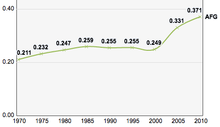
Da Afghanistan Bank serves as the central bank of the nation and the "Afghani" (AFN) is the national currency, with an exchange rate of about 47 Afghanis to 1 US dollar. Since 2003, over 16 new banks have opened in the country, including Afghanistan International Bank, Kabul Bank, Azizi Bank, Pashtany Bank, Standard Chartered Bank, and First Micro Finance Bank.
One of the main drivers for the current economic recovery is the return of over 5 million expatriates, who brought with them fresh energy, entrepreneurship and wealth-creating skills as well as much needed funds to start up businesses. For the first time since the 1970s, Afghans have involved themselves in construction, one of the largest industries in the country.[143] Some of the major national construction projects include $35 billion New Kabul City next to the capital, Ghazi Amanullah Khan City near Jalalabad, and Aino Mena in Kandahar.[144][145][146] Similar development projects have also begun in Herat, Mazar-e-Sharif, and other cities.[147]
In addition, a number of companies and small factories began operating in different parts of the country, which not only provide revenues to the government but also create new jobs. Improvements to the business environment have resulted in more than $1.5 billion in telecom investment and created more than 100,000 jobs since 2003.[148] Afghan rugs are becoming popular again, allowing many carpet dealers around the country to hire more workers.
Afghanistan is a member of WTO, SAARC, ECO, and OIC. It holds an observer status in SCO. Foreign Minister Zalmai Rassoul told the media in 2011 that his nation's "goal is to achieve an Afghan economy whose growth is based on trade, private enterprise and investment".[149] Experts believe that this will revolutionize the economy of the region. Opium production in Afghanistan soared to a record in 2007 with about 3 million people reported to be involved in the business,[150] but then declined significantly in the years following.[151] The government started programs to help reduce poppy cultivation, and by 2010 it was reported that 24 out of the 34 provinces were free from poppy growing. In June 2012, India advocated for private investments in the resource rich country and the creation of a suitable environment therefor.[152]
Mining
Michael E. O'Hanlon of the Brookings Institution estimated that if Afghanistan generates about $10 bn per year from its mineral deposits, its gross national product would double and provide long-term funding for Afghan security forces and other critical needs.[153] The United States Geological Survey (USGS) estimated in 2006 that northern Afghanistan has an average 2.9 billion (bn) barrels (bbl) of crude oil, 15.7 trillion cubic feet (440 bn m3) of natural gas, and 562 million bbl of natural gas liquids.[154] In 2011, Afghanistan signed an oil exploration contract with China National Petroleum Corporation (CNPC) for the development of three oil fields along the Amu Darya river in the north.[155]
The country has significant amounts of lithium, copper, gold, coal, iron ore, and other minerals.[102][103][156] The Khanashin carbonatite in Helmand Province contains 1,000,000 metric tons (1,100,000 short tons) of rare earth elements.[157] In 2007, a 30-year lease was granted for the Aynak copper mine to the China Metallurgical Group for $3 billion,[158] making it the biggest foreign investment and private business venture in Afghanistan's history.[159] The state-run Steel Authority of India won the mining rights to develop the huge Hajigak iron ore deposit in central Afghanistan.[160] Government officials estimate that 30% of the country's untapped mineral deposits are worth between $900 bn and $3 trillion.[104] One official asserted that "this will become the backbone of the Afghan economy" and a Pentagon memo stated that Afghanistan could become the "Saudi Arabia of lithium".[161] In a 2011 news story, the CSM reported, "The United States and other Western nations that have borne the brunt of the cost of the Afghan war have been conspicuously absent from the bidding process on Afghanistan's mineral deposits, leaving it mostly to regional powers."[162]
Transport
Air
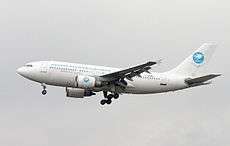
Air transport in Afghanistan is provided by the national carrier, Ariana Afghan Airlines (AAA), and by private companies such as Afghan Jet International, East Horizon Airlines, Kam Air, Pamir Airways, and Safi Airways. Airlines from a number of countries also provide flights in and out of the country. These include Air India, Emirates, Gulf Air, Iran Aseman Airlines, Pakistan International Airlines, and Turkish Airlines.
The country has four international airports: Herat International Airport, Hamid Karzai International Airport (formerly Kabul International Airport), Kandahar International Airport, and Mazar-e Sharif International Airport. There are also around a dozen domestic airports with flights to Kabul or Herat.
Rail
As of 2014, the country has only two rail links, one a 75 km line from Kheyrabad to the Uzbekistan border and the other a 10 km long line from Toraghundi to the Turkmenistan border. Both lines are used for freight only and there is no passenger service as of yet. There are various proposals for the construction of additional rail lines in the country.[163] In 2013, the presidents of Afghanistan, Turkmenistan, and Uzbekistan attended the groundbreaking ceremony for a 225 km line between Turkmenistan-Andkhvoy-Mazar-i-Sharif-Kheyrabad. The line will link at Kheyrabad with the existing line to the Uzbekistan border.[164] Plans exist for a rail line from Kabul to the eastern border town of Torkham, where it will connect with Pakistan Railways.[165] There are also plans to finish a rail line between Khaf, Iran and Herat, Afghanistan.[166]
Roads
Traveling by bus in Afghanistan remains dangerous due to militant activities.[167] The buses are usually older model Mercedes-Benz and owned by private companies. Serious traffic accidents are common on Afghan roads and highways, particularly on the Kabul–Kandahar and the Kabul–Jalalabad Road.[168]
Newer automobiles have recently become more widely available after the rebuilding of roads and highways. They are imported from the United Arab Emirates through Pakistan and Iran. As of 2012, vehicles more than 10 years old are banned from being imported into the country. The development of the nation's road network is a major boost for the economy due to trade with neighboring countries. Postal services in Afghanistan are provided by the publicly owned Afghan Post and private companies such as FedEx, DHL, and others.
Communication
Telecommunication services in the country are provided by Afghan Wireless, Etisalat, Roshan, MTN Group, and Afghan Telecom. In 2006, the Afghan Ministry of Communications signed a $64.5 million agreement with ZTE for the establishment of a countrywide optical fiber cable network. As of 2011, Afghanistan had around 17 million GSM phone subscribers and over 1 million internet users, but only had about 75,000 fixed telephone lines and a little over 190,000 CDMA subscribers.[169] 3G services are provided by Etisalat and MTN Group. In 2014, Afghanistan leased a space satellite from Eutelsat, called AFGHANSAT 1.[170]
Health
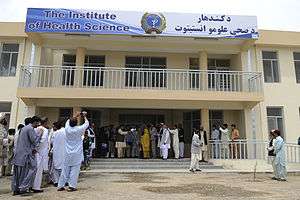
According to the Human Development Index, Afghanistan is the 15th least developed country in the world. The average life expectancy is estimated to be around 60 years for both sexes.[171] The country has one of the highest maternal mortality rate in the world as well as the highest infant mortality rate in the world (deaths of babies under one year), estimated in 2015 to be 115.08 deaths/1,000 live births.[5] The Ministry of Public Health plans to cut the infant mortality rate to 400 for every 100,000 live births before 2020.[172] The country currently has more than 3,000 midwives, with an additional 300 to 400 being trained each year.[173]
A number of hospitals and clinics have been built over the last decade, with the most advanced treatments being available in Kabul. The French Medical Institute for Children and Indira Gandhi Childrens Hospital in Kabul are the leading children's hospitals in the country. Some of the other main hospitals in Kabul include the 350-bed Jamhuriat Hospital and the Jinnah Hospital, which is still under construction. There are also a number of well-equipped military-controlled hospitals in different regions of the country.
It was reported in 2006 that nearly 60% of the population lives within a two-hour walk of the nearest health facility, up from 9% in 2002.[174] The latest surveys show that 57% of Afghans say they have good or very good access to clinics or hospitals.[173] The nation has one of the highest incidences of people with disabilities, with around a million people affected.[175] About 80,000 people are missing limbs; most of these were injured by landmines.[176][177] Non-governmental charities such as Save the Children and Mahboba's Promise assist orphans in association with governmental structures.[178] Demographic and Health Surveys is working with the Indian Institute of Health Management Research and others to conduct a survey in Afghanistan focusing on maternal death, among other things.[179]
Education
Education in the country includes K–12 and higher education, which is supervised by the Ministry of Education and the Ministry of Higher Education.[180] The nation's education system was destroyed due to the decades of war, but it began reviving after the Karzai administration came to power in late 2001. More than 5,000 schools were built or renovated in the last decade, with more than 100,000 teachers being trained and recruited.[181] More than seven million male and female students are enrolled in schools,[181] with about 100,000 being enrolled in different universities around the country; at least 35% of these students are female. As of 2013, there are 16,000 schools across Afghanistan. Education Minister Ghulam Farooq Wardak stated that another 8,000 schools are required to be constructed for the remaining 3 million children who are deprived of education.[182]
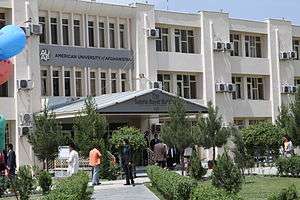
Kabul University reopened in 2002 to both male and female students. In 2006, the American University of Afghanistan was established in Kabul, with the aim of providing a world-class, English-language, co-educational learning environment in Afghanistan. The capital of Kabul serves as the learning center of Afghanistan, with many of the best educational institutions being based there. Major universities outside of Kabul include Kandahar University in the south, Herat University in the northwest, Balkh University in the north, Nangarhar University and Khost University in the east. The National Military Academy of Afghanistan, modeled after the United States Military Academy at West Point, is a four-year military development institution dedicated to graduating officers for the Afghan Armed Forces. The $200 million Afghan Defense University is under construction near Qargha in Kabul. The United States is building six faculties of education and five provincial teacher training colleges around the country, two large secondary schools in Kabul, and one school in Jalalabad.[181]
The literacy rate of the entire population has been very low but is now rising because more students go to schools.[183] In 2010, the United States began establishing a number of Lincoln learning centers in Afghanistan. They are set up to serve as programming platforms offering English language classes, library facilities, programming venues, Internet connectivity, and educational and other counseling services. A goal of the program is to reach at least 4,000 Afghan citizens per month per location.[184][185] The Afghan National Security Forces are provided with mandatory literacy courses.[183] In addition to this, Baghch-e-Simsim (based on the American Sesame Street) was launched in late 2011 to help young Afghan children learn.
In 2009 and 2010, a 5,000 OLPC – One Laptop Per Child schools deployment took place in Kandahar with funding from an anonymous foundation.[186] The OLPC team seeks local support to undertake larger deployment.[187][188]
Culture
| Part of a series on the |
| Culture of Afghanistan |
|---|
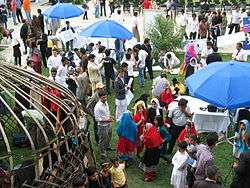 |
| History |
| People |
| Languages |
|
Mythology and folklore
|
| Cuisine |
| Festivals |
| Religion |
|
Art
|
|
Literature |
|
Music and performing arts
|
| Sport |
|
Monuments |
|
The Afghan culture has been around for over two millennia, tracing back to at least the time of the Achaemenid Empire in 500 BCE.[189][190] It is mostly a nomadic and tribal society, with different regions of the country having their own traditions, reflecting the multi-cultural and multi-lingual character of the nation. In the southern and eastern region the people live according to the Pashtun culture by following Pashtunwali, which is an ancient way of life that is still preserved.[191] The remainder of the country is culturally Persian and Turkic. Some non-Pashtuns who live in proximity with Pashtuns have adopted Pashtunwali[192] in a process called Pashtunization (or Afghanization), while some Pashtuns have been Persianized. Millions of Afghans who have been living in Pakistan and Iran over the last 30 years have been influenced by the cultures of those neighboring nations.
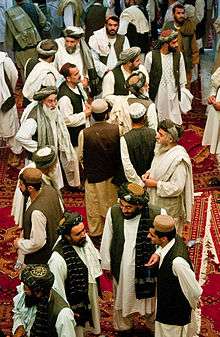
Afghans display pride in their culture, nation, ancestry, and above all, their religion and independence. Like other highlanders, they are regarded with mingled apprehension and condescension, for their high regard for personal honor, for their tribe loyalty and for their readiness to use force to settle disputes.[193] As tribal warfare and internecine feuding has been one of their chief occupations since time immemorial, this individualistic trait has made it difficult for foreigners to conquer them. Tony Heathcote considers the tribal system to be the best way of organizing large groups of people in a country that is geographically difficult, and in a society that, from a materialistic point of view, has an uncomplicated lifestyle.[193] There are an estimated 60 major Pashtun tribes,[194] and the Afghan nomads are estimated at about 2–3 million.[195]
The nation has a complex history that has survived either in its current cultures or in the form of various languages and monuments. However, many of its historic monuments have been damaged in recent wars.[196] The two famous Buddhas of Bamiyan were destroyed by the Taliban, who regarded them as idolatrous. Despite that, archaeologists are still finding Buddhist relics in different parts of the country, some of them dating back to the 2nd century.[197][198][199] This indicates that Buddhism was widespread in Afghanistan. Other historical places include the cities of Herat, Kandahar, Ghazni, Mazar-i-Sharif, and Zarang. The Minaret of Jam in the Hari River valley is a UNESCO World Heritage site. A cloak reputedly worn by Islam's prophet Muhammad is kept inside the Shrine of the Cloak in Kandahar, a city founded by Alexander and the first capital of Afghanistan. The citadel of Alexander in the western city of Herat has been renovated in recent years and is a popular attraction for tourists. In the north of the country is the Shrine of Hazrat Ali, believed by many to be the location where Ali was buried. The Afghan Ministry of Information and Culture is renovating 42 historic sites in Ghazni until 2013, when the province will be declared as the capital of Islamic civilization.[200] The National Museum of Afghanistan is located in Kabul.
Although literacy is low, classic Persian and Pashto poetry plays an important role in the Afghan culture. Poetry has always been one of the major educational pillars in the region, to the level that it has integrated itself into culture. Some notable poets include Rumi, Rabi'a Balkhi, Sanai, Jami, Khushal Khan Khattak, Rahman Baba, Khalilullah Khalili, and Parween Pazhwak.[201]
Media and entertainment
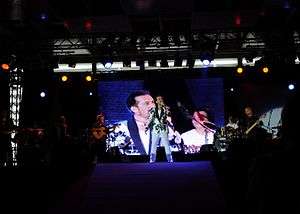
The Afghan mass media began in the early 20th century, with the first newspaper published in 1906. By the 1920s, Radio Kabul was broadcasting local radio services. Afghanistan National Television was launched in 1974 but was closed in 1996 when the media was tightly controlled by the Taliban.[202] Since 2002, press restrictions have been gradually relaxed and private media diversified. Freedom of expression and the press is promoted in the 2004 constitution and censorship is banned, although defaming individuals or producing material contrary to the principles of Islam is prohibited. In 2008, Reporters Without Borders ranked the media environment as 156 out of 173 countries, with the 1st being the most free. Around 400 publications were registered, at least 15 local Afghan television channels, and 60 radio stations.[203] Foreign radio stations, such as Voice of America, BBC World Service, and Radio Free Europe/Radio Liberty (RFE/RL) broadcast into the country.
The city of Kabul has been home to many musicians who were masters of both traditional and modern Afghan music. Traditional music is especially popular during the Nowruz (New Year) and National Independence Day celebrations. Ahmad Zahir, Nashenas, Ustad Sarahang, Sarban, Ubaidullah Jan, Farhad Darya, and Naghma are some of the notable Afghan musicians, but there are many others.[204] Most Afghans are accustomed to watching Indian Bollywood films and listening to its filmi hit songs. Many major Bollywood film stars have roots in Afghanistan, including Salman Khan, Saif Ali Khan, Shah Rukh Khan (SRK), Aamir Khan, Feroz Khan, Kader Khan, Naseeruddin Shah, Zarine Khan and Celina Jaitly. In addition, several Bollywood films, such as Dharmatma, Khuda Gawah, Escape from Taliban, and Kabul Express have been shot inside Afghanistan.
Sports
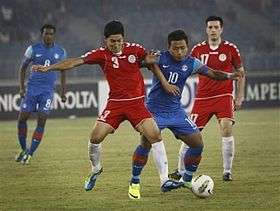
In recent years, Afghan sports teams have increasingly celebrated titles at international events. Afghanistan's basketball team won the first team sports title at the 2010 South Asian Games. Later that year, the country's cricket team followed as it won the 2010 ICC Intercontinental Cup.[205] In 2012, the country's 3x3 basketball team won the gold medal at the 2012 Asian Beach Games,[206] in 2013, Afghanistan's football team followed as it won the SAFF Championship.
Cricket is the country's most popular sport, followed by association football.[207] The Afghan national cricket team, which was formed in the last decade, participated in the 2009 ICC World Cup Qualifier, 2010 ICC World Cricket League Division One and the 2010 ICC World Twenty20. It won the ACC Twenty20 Cup in 2007, 2009, 2011 and 2013. The team eventually made it to play in the 2015 Cricket World Cup. The Afghanistan Cricket Board (ACB) is the official governing body of the sport and is headquartered in Kabul. The Ghazi Amanullah Khan International Cricket Stadium serves as the nation's main cricket stadium, followed by the Kabul National Cricket Stadium. Several other stadiums are under construction.[208] Domestically, cricket is played between teams from different provinces.
The Afghanistan national football team has been competing in international football since 1941. The national team plays its home games at the Ghazi Stadium in Kabul, while football in Afghanistan is governed by the Afghanistan Football Federation. The national team has never competed or qualified for the FIFA World Cup, but has recently won an international football trophy in 2013. The country also has a national team in the sport of futsal, a 5-a-side variation of football.
Other popular sports in Afghanistan include basketball, volleyball, taekwondo, and bodybuilding.[209] Buzkashi is a traditional sport, mainly among the northern Afghans. It is similar to polo, played by horsemen in two teams, each trying to grab and hold a goat carcass. The Afghan Hound (a type of running dog) originated in Afghanistan and was originally used in hunting.
See also
- Afghanistanism
- Bibliography of Afghanistan
- Environmental issues in Afghanistan
- Index of Afghanistan-related articles
- International rankings of Afghanistan
- List of power stations in Afghanistan
- Outline of Afghanistan
Notes
References
- 1 2 "Article Sixteen of the 2004 Constitution of Afghanistan". 2004. Archived from the original on 28 October 2013. Retrieved 13 June 2012.
From among the languages of Pashto, Dari, Uzbeki, Turkmani, Baluchi, Pashai, Nuristani, Pamiri (alsana), Arab and other languages spoken in the country, Pashto and Dari are the official languages of the state.
- ↑ Dictionary.com. The American Heritage Dictionary of the English Language, Fourth Edition. Houghton Mifflin Company, 2004. Reference.com (Retrieved 13 November 2007).
- ↑ Dictionary.com. WordNet 3.0. Princeton University. Reference.com (Retrieved 13 November 2007). Archived 28 March 2014 at the Wayback Machine.
- ↑ Central Statistics Organization of Afghanistan: Statistical Yearbook 2012–2013: Area and administrative Population Archived 17 December 2015 at the Wayback Machine.
- 1 2 3 4 5 6 7 8 9 "Afghanistan". The World Factbook. CIA. Retrieved 5 September 2015.
- 1 2 3 4 "Afghanistan". International Monetary Fund. Retrieved 26 April 2014.
- ↑ "Gini Index". World Bank. Archived from the original on 11 May 2014. Retrieved 2 March 2011.
- ↑ "2015 Human Development Report" (PDF). United Nations Development Programme. 14 December 2015. p. 18. Retrieved 14 December 2015.
- 1 2
- "U.S. maps". Pubs.usgs.gov. Archived from the original on 25 December 2013. Retrieved 19 May 2012.
- "South Asia: Data, Projects, and Research". Retrieved 2 March 2015.
- "MAPS SHOWING GEOLOGY, OIL AND GAS FIELDS AND GEOLOGICAL PROVINCES OF SOUTH ASIA (Includes Afghanistan)". Retrieved 2 March 2015.
- "University of Washington Jackson School of International Studies: The South Asia Center". Archived from the original on 2 April 2015. Retrieved 2 March 2015.
- "Syracruse University: The South Asia Center". Retrieved 2 March 2015.
- "Center for South Asian studies". Retrieved 2 March 2015.
- ↑ Griffin, Luke (14 January 2002). "The Pre-Islamic Period". Afghanistan Country Study. Illinois Institute of Technology. Archived from the original on 3 November 2001. Retrieved 14 October 2010.
- ↑ "Constitution of Afghanistan". 2004. Retrieved 16 February 2013.
- 1 2 "Afghanistan – John Ford Shroder, University of Nebraska". Webcitation.org. Archived from the original on 31 October 2009. Retrieved 19 May 2012.
- ↑ "Afghanistan: A Treasure Trove for Archaeologists". Time Magazine. 26 February 2009. Archived from the original on 26 July 2013. Retrieved 13 July 2011.
- ↑ The Indo-Aryans of Ancient South Asia: Language, Material Culture and Ethnicity by George Erdosy, p.321
- ↑ The History of Afghanistan by Meredith L. Runion, p.44-49
- ↑ The Ancient Indus: Urbanism, Economy, and Society. pp.1
- ↑ Kenoyer, Jonathan Mark (1998). Ancient cities of the Indus Valley Civilisation. pp.96
- ↑ Bryant, Edwin F. (2001) The quest for the origins of Vedic culture: the Indo-Aryan migration debate Oxford University Press, ISBN 978-0-19-513777-4.
- ↑ Afghanistan: ancient Ariana (1950), Information Bureau, p3.
- ↑ "Chronological History of Afghanistan – the cradle of Gandharan civilisation". Gandhara.com.au. 15 February 1989. Retrieved 19 May 2012.
- 1 2 3 "Country Profile: Afghanistan" (PDF). Library of Congress Country Studies on Afghanistan. August 2008. Archived from the original (PDF) on 8 April 2014. Retrieved 10 October 2010.
- ↑ The History of Afghanistan by Meredith L. Runion, p.44
- ↑ "Afghan and Afghanistan". Abdul Hai Habibi. alamahabibi.com. 1969. Retrieved 17 November 2015.
- ↑ "A.—The Hindu Kings of Kábul". Sir H. M. Elliot. London: Packard Humanities Institute. 1867–1877. Archived from the original on 8 April 2014. Retrieved 18 September 2010.
- ↑ ?amd-Allah Mustawfi of Qazwin (1340). "The Geographical Part of the NUZHAT-AL-QULUB". Translated by Guy Le Strange. Packard Humanities Institute. Archived from the original on 26 July 2013. Retrieved 19 August 2011.
- ↑ "A.—The Hindu Kings of Kábul (p.3)". Sir H. M. Elliot. London: Packard Humanities Institute. 1867–1877. Archived from the original on 26 July 2013. Retrieved 18 September 2010.
- ↑ "Central Asian world cities". Faculty.washington.edu. 29 September 2007. Archived from the original on 23 July 2013. Retrieved 6 May 2012.
- ↑ Page, Susan (18 February 2009). "Obama's war: Deploying 17,000 raises stakes in Afghanistan". Usatoday.com. Retrieved 19 May 2012.
- ↑ "Khurasan". The Encyclopaedia of Islam. Brill. 2009. p. 55. Archived from the original on 9 February 2014.
In pre-Islamic and early Islamic times, the term "Khurassan" frequently had a much wider denotation, covering also parts of what are now Soviet Central Asia and Afghanistan
- ↑ Ibn Battuta (2004). Travels in Asia and Africa, 1325–1354 (reprint, illustrated ed.). Routledge. p. 416. ISBN 978-0-415-34473-9. Archived from the original on 5 April 2014.
- ↑ Muhammad Qasim Hindu Shah (1560). "Chapter 200: Translation of the Introduction to Firishta's History". The History of India. 6. Sir H. M. Elliot. London: Packard Humanities Institute. p. 8. Archived from the original on 26 July 2013. Retrieved 22 August 2010.
- 1 2 Edward G. Browne. "A Literary History of Persia, Volume 4: Modern Times (1500–1924), Chapter IV. An Outline Of The History Of Persia During The Last Two Centuries (A.D. 1722–1922)". Packard Humanities Institute. Archived from the original on 26 July 2013. Retrieved 9 September 2010.
- ↑ "Ahmad Shah Durrani". Encyclopædia Britannica Online. Archived from the original on 4 April 2014. Retrieved 9 September 2010.
- ↑ Friedrich Engels (1857). "Afghanistan". Andy Blunden. The New American Cyclopaedia, Vol. I. Archived from the original on 27 April 2014. Retrieved 25 August 2010.
- ↑ The Oxford Dictionary of Islam by John L. Esposito, p.71
- ↑ Tanner, Stephen (2009). Afghanistan: A Military History from Alexander the Great to the War against the Taliban. Da Capo Press. p. 126. ISBN 978-0-306-81826-4. Archived from the original on 23 January 2014.
- ↑ Nalwa, Vanit (2009). Hari Singh Nalwa, "champion of the Khalsaji" (1791–1837). p. 198. ISBN 978-81-7304-785-5. Archived from the original on 22 January 2014.
- ↑ Chahryar, Adle (2003). History of Civilizations of Central Asia: Development in contrast: from the sixteenth to the mid-nineteenth century. UNESCO. p. 296. ISBN 978-92-3-103876-1.
- ↑ Edward Ingram. The International History Review, Vol. 2, No. 2 (Apr. 1980), pp. 160-171. Published by: Taylor & Francis, Ltd. Stable URL: http://www.jstor.org/stable/40105749 Great Britain's Great Game: An Introduction
- ↑ In Defence of British India: Great Britain in the Middle East, 1775-1842 By Edward Ingram. Frank Cass & Co, London, 1984. ISBN 0714632465. p7-19
- ↑ Encyclopedia Americana. Volume 25. Americana Corporation. 1976. p. 24.
- ↑ Bowersox, Gary W. (2004). The Gem Hunter: The Adventures of an American in Afghanistan. United States: GeoVision, Inc.,. p. 100. ISBN 0-9747323-1-1. Retrieved 22 August 2010.
To launch this plan, Bhutto recruited and trained a group of Afghans in the Bala-Hesar of Peshawar, in Pakistan's North-west Frontier Province. Among these young men were Massoud, Gulbuddin Hekmatyar, and other members of Jawanan-e Musulman. Massoud's mission to Bhutto was to create unrest in northern Afghanistan. It served Massoud's interests, which were apparently opposition to the Soviets and independence for Afghanistan. Later, after Massoud and Hekmatyar had a terrible falling-out over Massoud's opposition to terrorist tactics and methods, Massoud overthrew from Jawanan-e Musulman. He joined Rabani's newly created Afghan political party, Jamiat-i-Islami, in exile in Pakistan.
- ↑ Hussain, Rizwan (2005). Pakistan And The Emergence Of Islamic Militancy In Afghanistan. Ashgate Publishing. pp. 108–109. ISBN 978-0-7546-4434-7.
- ↑ Kalinovsky, Artemy M. (2011). A Long Goodbye: The Soviet Withdrawal from Afghanistan. Harvard University Press. pp. 25–28. ISBN 978-0-674-05866-8.
- 1 2 "Afghanistan". Library of Congress Country Studies. Retrieved 14 November 2010.
- ↑ Meher, Jagmohan (2004). America's Afghanistan War: The Success that Failed. Gyan Books. pp. 68–69, 94. ISBN 978-81-7835-262-6.
- ↑ "Story of US, CIA and Taliban". The Brunei Times. 2009. Archived from the original on 5 December 2013. Retrieved 16 December 2013.
- ↑ "The Cost of an Afghan 'Victory'". The Nation. 1999. Archived from the original on 2 March 2014. Retrieved 16 December 2013.
- ↑ "Soldiers of God: Cold War (Part 1/5)". CNN. 1998. Archived from the original on 29 July 2013. Retrieved 11 October 2011.
- ↑ UNICEF, Land-mines: A deadly inheritance Archived 5 August 2013 at the Wayback Machine.
- ↑ "Landmines in Afghanistan: A Decades Old Danger". Defenseindustrydaily.com. 1 February 2010. Archived from the original on 11 January 2014. Retrieved 6 May 2012.
- ↑ "Refugee Admissions Program for Near East and South Asia". Bureau of Population, Refugees, and Migration. Archived from the original on 13 April 2014. Retrieved 29 December 2013.
- ↑ "Afghanistan: History – Columbia Encyclopedia". Infoplease.com. 11 September 2001. Archived from the original on 10 August 2012. Retrieved 19 May 2012.
- ↑ Afghanistan Country Study Guide Volume 1 Strategic Information and Developments by INB, p.73
- ↑ Amin Saikal. Modern Afghanistan: A History of Struggle and Survival (2006 1st ed.). I.B. Tauris & Co Ltd., London New York. p. 352. ISBN 978-1-85043-437-5.
- 1 2 "Blood-Stained Hands, Past Atrocities in Kabul and Afghanistan's Legacy of Impunity". Human Rights Watch. Archived from the original on 12 December 2009.
- ↑ GUTMAN, Roy (2008): How We Missed the Story: Osama Bin Laden, the Taliban and the Hijacking of Afghanistan, Endowment of the United States Institute of Peace, 1st ed., Washington D.C.
- ↑ "The September 11 Sourcebooks Volume VII: The Taliban File". gwu.edu. 2003. Archived from the original on 31 October 2013. Retrieved 16 December 2013.
- 1 2 "Casting Shadows: War Crimes and Crimes against Humanity: 1978–2001" (PDF). Afghanistan Justice Project. 2005. Archived from the original (PDF) on 4 October 2013. Retrieved 16 December 2013.
- 1 2 3 4 "II. BACKGROUND". Human Rights Watch. Archived from the original on 2 November 2008. Retrieved 16 December 2013.
- ↑ Matinuddin, Kamal, The Taliban Phenomenon, Afghanistan 1994–1997, Oxford University Press, (1999), pp. 25–26
- ↑ Amnesty International. "Document – Afghanistan: further information on fear for safety and new concern: Deliberate and arbitrary killings: Civilians in Kabul." 16 November 1995 Accessed at: Amnesty.org Archived 26 July 2013 at the Wayback Machine.
- 1 2 Marcela Grad. Massoud: An Intimate Portrait of the Legendary Afghan Leader (1 March 2009 ed.). Webster University Press. p. 310.
- 1 2 "Documents Detail Years of Pakistani Support for Taliban, Extremists". George Washington University. 2007. Archived from the original on 3 December 2013. Retrieved 16 December 2013.
- ↑ Coll, Ghost Wars (New York: Penguin, 2005), 14.
- ↑ "The Taliban's War on Women. A Health and Human Rights Crisis in Afghanistan" (PDF). Physicians for Human Rights. 1998. Archived from the original (PDF) on 14 June 2007.
- 1 2 "Inside the Taliban". National Geographic. 2007. Archived from the original on 29 July 2013.
- ↑ "Ahmed Shah Massoud". History Commons. 2010. Archived from the original on 25 January 2014. Retrieved 16 December 2013.
- ↑ Maley, William (2009). The Afghanistan wars. Palgrave Macmillan. p. 288. ISBN 978-0-230-21313-5.
- ↑ Rashid, Ahmed (11 September 2001). "Afghanistan resistance leader feared dead in blast". The Telegraph. London. Archived from the original on 8 November 2013.
- ↑ "Brigade 055". CNN. Archived from the original on 29 July 2013.
- ↑ "Inside the Taliban". National Geographic. 2007. Archived from the original on 29 September 2008.
- ↑ "Life under Taliban cuts two ways". CSM. 20 September 2001 Archived 30 December 2013 at the Wayback Machine.
- ↑ Rory McCarthy in Islamabad (17 October 2001). "New offer on Bin Laden". London: Guardian. Archived from the original on 28 June 2013. Retrieved 17 July 2012.
- ↑ Tyler, Patrick (8 October 2001). "A Nation challenged: The attack; U.S. and Britain strike Afghanistan, aiming at bases and terrorist camps; Bush warns 'Taliban will pay a price'". New York Times. Archived from the original on 11 April 2014. Retrieved 28 February 2010.
- ↑ United Nations Security Council Resolution 1386. S/RES/1386(2001) 31 May 2001. Retrieved 21 September 2007. – (UNSCR 1386)
- ↑ "United States Mission to Afghanistan". Nato.usmission.gov. Archived from the original on 21 October 2010. Retrieved 14 November 2010.
- ↑ Fossler, Julie. "USAID Afghanistan". Afghanistan.usaid.gov. Archived from the original on 17 October 2010. Retrieved 14 November 2010.
- ↑ "Canada's Engagement in Afghanistan: Backgrounder". Afghanistan.gc.ca. 9 July 2010. Archived from the original on 19 November 2010. Retrieved 14 November 2010.
- ↑ "Pakistan Accused of Helping Taliban". ABC News. 31 July 2008. Archived from the original on 21 December 2013. Retrieved 28 September 2010.
- ↑ Crilly, Rob; Spillius, Alex (26 July 2010). "Wikileaks: Pakistan accused of helping Taliban in Afghanistan attacks". The Telegraph. London. Archived from the original on 29 January 2014. Retrieved 28 September 2010.
- ↑ "Germany begins deportations of Afghan refugees". wsws.org. 25 June 2005. Archived from the original on 2 October 2012. Retrieved 2 October 2011.
- ↑ "Living in Fear of Deportation". DW-World.De. 22 January 2006. Archived from the original on 29 January 2012. Retrieved 2 October 2011.
- ↑ Witte, Griff (8 December 2009). "Taliban shadow officials offer concrete alternative". The Washington Post. Retrieved 30 March 2010.
- ↑ Mirwais Khan (15 July 2015). "Afghan Taliban leader backs peace talks with Kabul officials". Associated Press. Retrieved 11 June 2016.
- See also: Mullah Omar: Taliban leader 'died in Pakistan in 2013'
- See also: Afghanistan says Taliban leader Mullah Omar died 2 years ago
- So the question remains: If Omar died in 2013, who from the Taliban sanctioned peace talks in 2015 in Omar's name?
- ↑ "President Karzai Address to the Nation on Afghanistan's Peace Efforts". The Embassy of Afghanistan in Washington, DC. Archived from the original on 12 October 2011. Retrieved 10 October 2011.
- ↑ "U.S. blames Pakistan agency in Kabul attack". Reuters. 22 September 2011. Archived from the original on 25 September 2011. Retrieved 22 September 2011.
- ↑ "Panetta: U.S. will pursue Pakistan-based militants". USA Today. September 2011. Retrieved 21 September 2011.
- ↑ "Pentagon can't account for $1 billion in Afghan reconstruction aid". mcclatchydc.com. 23 April 2015. Retrieved 8 September 2015.
- ↑ "Afghan president Ashraf Ghani inaugurated after bitter campaign". The Guardian. Retrieved 12 April 2015.
- ↑ "U.S. formally ends the war in Afghanistan". CBS News. Retrieved 12 April 2015.
- ↑ "Afghan Civilians". Brown University. 2015. Retrieved 3 September 2015.
- ↑ "Composition of macro geographical (continental) regions, geographical sub-regions, and selected economic and other groupings". UNdata. 26 April 2011. Archived from the original on 13 July 2011. Retrieved 13 July 2011.
- ↑ "Afghanistan". Encyclopædia Britannica. Archived from the original on 25 February 2010. Retrieved 17 March 2010.
- ↑ "History of Environmental Change in the Sistan Basin 1976–2005" (PDF). Archived (PDF) from the original on 7 August 2007. Retrieved 20 July 2007.
- ↑ "Snow in Afghanistan: Natural Hazards". NASA. 3 February 2006. Archived from the original on 30 December 2013. Retrieved 6 May 2012.
- ↑ "Snow may end Afghan drought, but bitter winter looms". Reuters. 18 January 2012. Archived from the original on 30 December 2013.
- ↑ "Afghanistan's woeful water management delights neighbors". Csmonitor.com. 15 June 2010. Archived from the original on 14 November 2010. Retrieved 14 November 2010.
- ↑ Crone, Anthony J. (April 2007). Earthquakes Pose a Serious Hazard in Afghanistan (PDF) (Technical report). US Geological Survey. Fact Sheet FS 2007–3027. Archived from the original (PDF) on 27 July 2013. Retrieved 14 October 2011.
- ↑ "Earthquake Hazards". USGS Projects in Afghanistan. US Geological Survey. 1 August 2011. Retrieved 13 October 2011.
- ↑ "'Seven dead' as earthquake rocks Afghanistan". BBC News. 19 April 2010. Archived from the original on 31 December 2013. Retrieved 13 October 2011.
- 1 2 Peters, Steven G. (October 2007). Preliminary Assessment of Non-Fuel Mineral Resources of Afghanistan, 2007 (PDF) (Technical report). USGS Afghanistan Project/US Geological Survey/Afghanistan Geological Survey. Fact Sheet 2007–3063. Archived from the original (PDF) on 27 July 2013. Retrieved 13 October 2011.
- 1 2 "Minerals in Afghanistan" (PDF). British Geological Survey. Archived from the original (PDF) on 26 July 2013. Retrieved 4 December 2010.
- 1 2 "Afghans say US team found huge potential mineral wealth". BBC News. 14 June 2010. Archived from the original on 9 August 2013. Retrieved 13 October 2011.
- ↑ "Land area (sq. km)". World Development Indicators. World Bank. 2011. Archived from the original on 29 October 2013. Retrieved 13 October 2011.
- ↑ "CIA Factbook – Area: 41". CIA. 26 November 1991. Archived from the original on 31 January 2014. Retrieved 4 February 2012.
- 1 2 3 4 UNESCO, Country profile, http://www.uis.unesco.org/DataCentre/Pages/country-profile.aspx?code=AFG®ioncode=40535
- ↑ Ethnic map of Afghanistan, http://gulf2000.columbia.edu/images/maps/Afghanistan_Ethnic_lg.png
- ↑ "Afghanistan – Population Reference Bureau". Population Reference Bureau. Archived from the original on 2 December 2013. Retrieved 29 December 2009.
- ↑ "Estimated population of Afghanistan 2012-13". Central Statistics Office. Retrieved September 30, 2015.
- ↑ "Ethnic groups". The World Factbook. CIA. Archived from the original on 14 October 2013. Retrieved 18 September 2010.
Pashtun, Tajik, Hazara, Uzbek, other (includes smaller numbers of Baloch, Turkmen, Nuristani, Pamiri, Arab, Gujar, Brahui, Qizilbash, Aimaq, Pashai, and Kyrghyz) note: current statistical data on the sensitive subject of ethnicity in Afghanistan is not available, and ethnicity data from small samples of respondents to opinion polls are not a reliable alternative; Afghanistan's 2004 constitution recognizes 14 ethnic groups: Pashtun, Tajik, Hazara, Uzbek, Baloch, Turkmen, Nuristani, Pamiri, Arab, Gujar, Brahui, Qizilbash, Aimaq, and Pashai (2015)
- ↑ "Afghanistan". The World Factbook/Central Intelligence Agency. University of Missouri. 15 October 1991. Retrieved 20 March 2011.
- ↑ "Ethnic divisions". The World Factbook/CIA. University of Missouri. 22 January 1993. Retrieved 16 October 2010.
- ↑ "Ethnic Groups". Library of Congress Country Studies. 1997. Retrieved 8 October 2010.
- ↑ "Ethnic groups:". The World Factbook/CIA. University of Missouri. 2003. Retrieved 18 September 2010.
- ↑ "Languages of Afghanistan". Encyclopædia Britannica. Archived from the original on 12 November 2013.
- ↑ "Afghanistan is among worst places on globe for women's health, say UNICEF and CDC". unicef.org. UNICEF. Retrieved 3 November 2016.
- ↑ "Chapter 1: Religious Affiliation". The World’s Muslims: Unity and Diversity. Pew Research Center's Religion & Public Life Project. 9 August 2012. Retrieved 4 September 2013.
- ↑ Klimberg, Max (1 October 2004). "NURISTAN". Encyclopædia Iranica (online ed.). United States: Columbia University. Archived from the original on 26 July 2013.
- ↑ Lavina Melwani. "Hindus Abandon Afghanistan". Hinduism Today. Archived from the original on 11 January 2007. Retrieved 19 May 2012.
- ↑ Majumder, Sanjoy (25 September 2003). "Sikhs struggle in Afghanistan". BBC News. Archived from the original on 22 February 2009. Retrieved 19 May 2012.
- ↑ N.C. Aizenman (27 January 2005). "Afghan Jew Becomes Country's One and Only". Washingtonpost.com. Retrieved 19 May 2012.
- ↑ "The Supreme Court Chief Justice Biography". supremecourt.gov.af.
- ↑ "Database". afghan-bios.info.
- ↑ "Corruption widespread in Afghanistan, UNODC survey says". UNODC.org. 19 January 2010. Archived from the original on 16 April 2014. Retrieved 14 November 2010.
- ↑ "Karzai vows to tackle corruption". CBC.ca. 9 November 2009. Archived from the original on 30 December 2013. Retrieved 14 November 2010.
- ↑ "Corruption Perceptions Index 2014 Results". Transparency International. Retrieved 5 September 2015.
- 1 2 Cooper, Helene (2 November 2009). "Karzai Gets New Term as Afghan Runoff is Scrapped". Nytimes.com. Archived from the original on 11 May 2011. Retrieved 4 February 2012.
- ↑ "RAWA Photo Gallery: They are Responsible for Afghanistan's Tragedy". RAWA. Archived from the original on 19 October 2010. Retrieved 11 October 2010.
- ↑ "Women in Parliaments: World Classification". Ipu.org. 30 November 2009. Archived from the original on 28 March 2014. Retrieved 29 December 2009.
- ↑ "Explaining Elections, Independent Election Commission of Afghanistan". Iec.org.af. 9 October 2004. Archived from the original on 27 August 2010. Retrieved 4 February 2012.
- ↑ "Mounting death toll for Afghan troops: US general". Yahoo News. 5 November 2014.
- ↑ Glasch, Mike. "USACE TAA employee named top engineer". Army.mil. US Army. Retrieved November 22, 2016.
- 1 2 Pellerindate, Cheryl (23 May 2011). "Afghan Security Forces Grow in Numbers, Quality". American Forces Press Service. United States Department of Defense. Archived from the original on 14 April 2014. Retrieved 10 July 2011.
- ↑ "For U.S., Vast Challenge To Expand Afghan Forces". NPR. Archived from the original on 30 December 2013. Retrieved 19 May 2012.
- ↑ 16 November 2009 (16 November 2009). "Afghanistan to Form Major Anti-Corruption Unit". voanews.com. Archived from the original on 20 November 2009. Retrieved 29 December 2009.
- ↑ Ministry of Counter Narcotics Archived 28 March 2014 at the Wayback Machine.
- ↑ "Afghanistan still one of the worst places to be a woman, says EU ambassador". The Guardian. 7 March 2014. Retrieved 3 November 2016.
- ↑ "Afghanistan: Food still unaffordable for millions". IRIN. 12 March 2009. Archived from the original on 27 August 2010. Retrieved 11 October 2010.
- ↑ "Agriculture". USAID. Archived from the original on 29 September 2013. Retrieved 20 October 2010.
- ↑ Exporting Afghanistan, by P.J. Tobia. 17 November 2009.
- ↑ http://www.unodc.org/pdf/publications/afg_opium_economy_www.pdf
- ↑ Gall, Carlotta (7 July 2010). "Afghan Companies Say U.S. Did Not Pay Them". New York Times. Archived from the original on 2 April 2013. Retrieved 30 September 2011.
- ↑ "the Kabul New City Official Website". DCDA. Archived from the original on 30 December 2013. Retrieved 4 February 2012.
- ↑ "Ghazi Amanullah Khan City". najeebzarab.af. 2009. Archived from the original on 29 April 2013. Retrieved 15 August 2011.
- ↑ "Case study: Aino Mina". Designmena.com. Archived from the original on 6 January 2014. Retrieved 4 February 2012.
- ↑ A Humane Afghan City? by Ann Marlowe in Forbes 2 September 2009. Archived 31 December 2013 at the Wayback Machine.
- ↑ "Economic Growth". USAID. Archived from the original on 29 September 2013. Retrieved 25 September 2011.
- ↑ "Afghanistan, neighbors unveil 'Silk Road' plan". Reuters. 22 September 2011. Archived from the original on 27 September 2011. Retrieved 24 September 2011.
- ↑ Declan Walsh (30 August 2007). "UN horrified by surge in opium trade in Helmand". Guardian. London. Archived from the original on 15 January 2008. Retrieved 19 May 2012.
- ↑ "Afghan opium production in significant decline". UNDOC. Archived from the original on 16 April 2014.
- ↑ "CEOs should replace generals in Afghanistan: India". 28 June 2012.
- ↑ O'Hanlon, Michael E. "Deposits Could Aid Ailing Afghanistan" Archived 23 September 2011 at the Wayback Machine., The Brookings Institution, 16 June 2010. Archived 23 September 2011 at the Wayback Machine.
- ↑ Klett, T.R. (March 2006). Assessment of Undiscovered Petroleum Resources of Northern Afghanistan, 2006 (PDF) (Technical report). USGS-Afghanistan Ministry of Mines & Industry Joint Oil & Gas Resource Assessment Team. Fact Sheet 2006–3031. Archived from the original (PDF) on 27 July 2013. Retrieved 13 October 2011.
- ↑ "Afghanistan signs '$7 bn' oil deal with China". 28 December 2011. Archived from the original on 30 December 2013. Retrieved 29 December 2013.
- ↑ "Afghanistan's Mineral Fortune". Institute for Environmental Diplomacy and Security Report. 2011. Archived from the original on 12 December 2013. Retrieved 16 December 2013.
- ↑ Tucker, Ronald D. (2011). Rare Earth Element Mineralogy, Geochemistry, and Preliminary Resource Assessment of the Khanneshin Carbonatite Complex, Helmand Province, Afghanistan (PDF) (Technical report). USGS. Open-File Report 2011–1207. Archived from the original (PDF) on 27 July 2013. Retrieved 13 October 2011.
- ↑ "China, Not U.S., Likely to Benefit from Afghanistan's Mineral Riches". Daily Finance. 14 June 2010 Archived 31 December 2013 at the Wayback Machine.
- ↑ "China Willing to Spend Big on Afghan Commerce". The New York Times. 29 December 2009. Archived from the original on 31 July 2011.
- ↑ "Indian Group Wins Rights to Mine in Afghanistan's Hajigak Archived 10 October 2013 at the Wayback Machine.". Businessweek. 6 December 2011 Archived 10 October 2013 at the Wayback Machine.
- ↑ Risen, James (17 June 2010). "U.S. Identifies Vast Riches of Minerals in Afghanistan". The New York Times. Archived from the original on 17 June 2010. Retrieved 14 November 2010.
- ↑ "China wins $700 million Afghan oil and gas deal. Why didn't the US bid?". CSMonitor.com. 28 December 2011 Archived 31 December 2013 at the Wayback Machine.
- ↑ Maps, Railways of Afghanistan, http://www.andrewgrantham.co.uk/afghanistan/tag/map/
- ↑ Three presidents launch construction of international rail link, 6 June 2013, http://www.railwaygazette.com/news/infrastructure/single-view/view/three-presidents-launch-construction-of-international-rail-link.html?sword_list[]=afghan&no_cache=1
- ↑ Tolo News – Construction on Kabul-Torkham Railway to Start Soon, Ministry of Mines Says Archived 9 November 2013 at the Wayback Machine., Tamim Shaheer. 18 October 2011. Archived 9 November 2013 at the Wayback Machine.
- ↑ Khaf-Herat railway, http://www.raillynews.com/2013/khaf-herat-railway/
- ↑ "Driving in Afghanistan". Caravanistan. Caravanistan. Retrieved November 22, 2016.
- ↑ "Afghan bus crash kills 45". theguardian.com. 26 April 2013. Retrieved 4 November 2014.
- ↑ "Statistics". Ministry of Communications (Afghanistan). 2006. Archived from the original on 29 March 2014. Retrieved 17 January 2012.
- ↑ Khetab, Muhammad Hassan (10 May 2014). "Afghanistan's maiden satellite launched". Pajhwok Afghan News. Retrieved 10 May 2014.
- ↑ "Afghanistan". World Health Organization (WHO). Archived from the original on 26 October 2013. Retrieved 6 July 2013.
Life expectancy at birth m/f (years) 59/61
- ↑ Tan Ee Lyn (6 May 2008). "Afghan medical college struggles to rise from the ashes". Reuters. Archived from the original on 31 October 2009. Retrieved 29 December 2009.
- 1 2 Peter, Tom A. (17 December 2011). "Childbirth and maternal health improve in Afghanistan". Christian Science Monitor. Archived from the original on 31 December 2013. Retrieved 12 January 2012.
- ↑ "Health". United States Agency for International Development (USAID). Archived from the original on 29 September 2013. Retrieved 20 October 2010.
- ↑ Anne-Marie DiNardo, LPA/PIPOS (31 March 2006). "Empowering Afghanistan's Disabled Population – 31 March 2006". Usaid.gov. Archived from the original on 8 May 2004. Retrieved 19 May 2012.
- ↑ Richard Norton-Taylor (13 February 2008). "Afghanistan's refugee crisis 'ignored'". Guardian. London. Archived from the original on 15 December 2010. Retrieved 19 May 2012.
- ↑ "Afghanistan: People living with disabilities call for integration Archived 20 September 2011 at the Wayback Machine.
- ↑ Virginia Haussegger Mahooba's Promise ABC TV 7.30 Report. 2009. ABC.net.au. Retrieved 15 July 2009. Archived 26 July 2013 at the Wayback Machine.
- ↑ "Afghanistan". Measuredhs.com. Archived from the original on 30 December 2013. Retrieved 14 November 2010.
- ↑ "Afghanistan's Ministry of Higher Education". Archived from the original on 31 May 2011. Retrieved 23 June 2011.
- 1 2 3 "Education". United States Agency for International Development (USAID). Retrieved 11 August 2011.
- ↑ "Wardak seeks $3b in aid for school buildings". Pajhwok Afghan News. 18 May 2013. Archived from the original on 30 December 2013. Retrieved 13 August 2013.
- 1 2 "Rising literacy in Afghanistan ensures transition". Army.mil. Archived from the original on 9 December 2013. Retrieved 4 February 2012.
- ↑ "Management and Establishment of Lincoln Learning Centers in Afghanistan" (PDF). Archived from the original (PDF) on 26 July 2013. Retrieved 19 May 2012.
- ↑ "Ghazni governor signs memorandum for Lincoln Learning Center – War On Terror News". Waronterrornews.typepad.com. 22 September 2010. Archived from the original on 31 December 2013. Retrieved 4 February 2012.
- ↑ "Interview with Carol Ruth Silver". 2011.
- ↑ "OLPC Afghanistan". laptop.org.
- ↑ Lima Ahmad; Kenneth Adams; Mike Dawson; Carol Ruth Silver. "Briefing Note – One Laptop Per Child (OLPC) in Afghanistan" (PDF). Retrieved 2 October 2014.
- ↑ "Country Profile: Afghanistan" (PDF). Library of Congress Country Studies on Afghanistan. August 2008. Archived from the original (PDF) on 8 April 2014. Retrieved 16 August 2010.
- ↑ Barbara Robson, Juliene Lipson, Farid Younos, Mariam Mehdi. "The Afghans – Their History and Culture". United States: Center for Applied Linguistics. 30 June 2002. Archived from the original on 5 January 2007. Retrieved 25 September 2010.
- ↑ US Library of Congress: Afghanistan – Ethnic Groups (Pashtun)
- ↑ Banting, Erinn (2003). Afghanistan: The land. Crabtree Publishing Company. p. 32. ISBN 978-0-7787-9335-9. Archived from the original on 31 December 2013.
- 1 2 Heathcote, Tony (1980, 2003) "The Afghan Wars 1839–1919", Sellmount Staplehurst.
- ↑ "Pashtun (people)". Encyclopædia Britannica. Archived 30 October 2013 at the Wayback Machine.
- ↑ "Afghanistan: Kuchi nomads seek a better deal". IRIN Asia. 18 February 2008. Archived 10 September 2011 at the Wayback Machine.
- ↑ G.V. Brandolini. Afghanistan cultural heritage. Orizzonte terra, Bergamo. 2007. p. 64.
- ↑ "42 Buddhist relics discovered in Logar". Maqsood Azizi. Pajhwok Afghan News. 18 August 2010. Archived from the original on 1 February 2012. Retrieved 23 August 2010. (bad URL - does not match page title)
- ↑ "Afghan archaeologists find Buddhist site as war rages". Sayed Salahuddin. News Daily. 17 August 2010. Archived from the original on 18 August 2010. Retrieved 16 August 2010.
- ↑ "Buddhist remains found in Afghanistan". Press TV. 17 August 2010. Archived from the original on 20 August 2010. Retrieved 16 August 2010.
- ↑ "Survey of historical sites in Ghazni launched". Pajhwok Afghan News. 27 August 2011. Archived from the original on 5 November 2013. Retrieved 27 August 2011.
- ↑ "Classical Dari and Pashto Poets". Afghan-web.com. Archived from the original on 6 October 2013. Retrieved 4 February 2012.
- ↑ Dartnell, M. Y. Insurgency Online: Web Activism and Global Conflict. University of Toronto Press, 2006. ISBN 978-0-8020-8553-5.
- ↑ Afghanistan Press Report 2008, Freedom House. Archived 23 June 2011 at the Wayback Machine.
- ↑ "Artist Biographies". Afghanland.com. Archived from the original on 9 August 2013. Retrieved 17 October 2011.
- ↑ 2009–10 Intercontinental Cup Archived 24 February 2013 at the Wayback Machine. at CricketEurope
- ↑ A Chronological History of Sports in Afghanistan at Afghanistan Online
- ↑ Farmer, Ben (28 September 2012). "Afghanistan launches first professional football league". Kabul: The Telegraph. Retrieved 29 September 2012.
- ↑ Javed Hamim Kakar (11 October 2010). "All provinces to have cricket grounds: minister". Pajhwok Afghan News. pajhwok.com. Archived from the original on 30 December 2013. Retrieved 14 September 2011.
- ↑ "Sports". Pajhwok Afghan News. pajhwok.com. Archived from the original on 9 February 2014. Retrieved 14 September 2011.
Further reading
Books
|
|
Articles
- Meek, James. Worse than a Defeat. London Review of Books, Vol. 36, No. 24, December 2014, pages 3–10
External links
| Wikisource has the text of the 1911 Encyclopædia Britannica article Afghanistan. |
- Office of the President
- "Afghanistan". The World Factbook. Central Intelligence Agency.
- Afghanistan web resources provided by GovPubs at the University of Colorado–Boulder Libraries
- Afghanistan at DMOZ
-
 Wikimedia Atlas of Afghanistan
Wikimedia Atlas of Afghanistan - Research Guide to Afghanistan

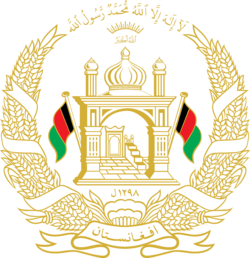


.png)